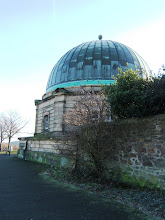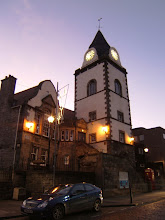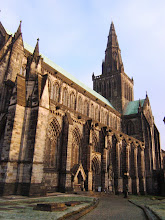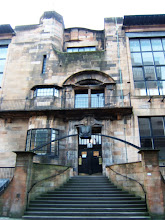
When I woke to brilliant sunshine, I knew I’d picked the right day for a trek to South Queensferry and the Forth Bridges. There was still frost on the park grass across the road when I left the hotel to catch the bus to the Scottish National Portrait Gallery at 1 Queen Street.
The gallery is a splendid neo-gothic, red sandstone building that was the world’s first purpose
 built portrait gallery when it opened in 1889. Since 1982, the gallery has commissioned portraits of living Scots by contemporary artists. The fantoushe Grand Hall is a wonderful introduction to Scottish History. I start my visit on the second floor and find portraits of some members of my Fuller family tree: John Dalrymple, 2nd Earl of Stair (1693-1747); Sir Hew Dalrymple, Lord Drummore (1690-1755); and Sir Gilbert Elliot, Lord Minto (1693-1766). [not my own family but one I'm researching] A sign on the door of the first floor galleries says: Please note that due to staff sickness this room will remain closed today. You’d think that they could have found away to open the different sections on a rotating basis using the staff who were not suffering from holiday hangovers. But, as there’s no admission charge how can you complain?
built portrait gallery when it opened in 1889. Since 1982, the gallery has commissioned portraits of living Scots by contemporary artists. The fantoushe Grand Hall is a wonderful introduction to Scottish History. I start my visit on the second floor and find portraits of some members of my Fuller family tree: John Dalrymple, 2nd Earl of Stair (1693-1747); Sir Hew Dalrymple, Lord Drummore (1690-1755); and Sir Gilbert Elliot, Lord Minto (1693-1766). [not my own family but one I'm researching] A sign on the door of the first floor galleries says: Please note that due to staff sickness this room will remain closed today. You’d think that they could have found away to open the different sections on a rotating basis using the staff who were not suffering from holiday hangovers. But, as there’s no admission charge how can you complain?My next stop is Calton Hill. The top of this volcanic hill at the east end of the downtown
 commands sweeping views of the city and the Forth Estuary. It’s also home to an odd collection of buildings and structures. I’m reminded of John “Mad Jack” Fuller’s follies. He built a Greek temple, a tower, an observatory, an obelisk and a pyramid on and around his property in Brightling, Sussex. The only thing missing on Calton Hill is a pyramid. The Nelson Monument is a tower shaped like an upturned telescope. Built in 1807 it has an internal spiral staircase of 143 steps. The largest building on Calton Hill is the city observatory built in 1818. Both it and the adjacent Observatory House are closed for renovations. In 1826 work began on The National Monument, a replica of the Parthenon, which was meant to commemorate the fallen in the Napoleonic wars. When the funds dried up in 1829 work stopped with only the façade having been completed. No one has ever attempted to finish the project. Philosopher Dugald Stewart’s monument is a rotunda temple modeled on the Tower of the Winds in Athens. It was
commands sweeping views of the city and the Forth Estuary. It’s also home to an odd collection of buildings and structures. I’m reminded of John “Mad Jack” Fuller’s follies. He built a Greek temple, a tower, an observatory, an obelisk and a pyramid on and around his property in Brightling, Sussex. The only thing missing on Calton Hill is a pyramid. The Nelson Monument is a tower shaped like an upturned telescope. Built in 1807 it has an internal spiral staircase of 143 steps. The largest building on Calton Hill is the city observatory built in 1818. Both it and the adjacent Observatory House are closed for renovations. In 1826 work began on The National Monument, a replica of the Parthenon, which was meant to commemorate the fallen in the Napoleonic wars. When the funds dried up in 1829 work stopped with only the façade having been completed. No one has ever attempted to finish the project. Philosopher Dugald Stewart’s monument is a rotunda temple modeled on the Tower of the Winds in Athens. It was  completed in 1831, the work of architect William Henry Playfair. The obelisk seen from Calton Hill is actually in the nearby Old Burial Ground and was built by Thomas Hamilton to honour the political martyrs of 1793 (I need to know more about this).
completed in 1831, the work of architect William Henry Playfair. The obelisk seen from Calton Hill is actually in the nearby Old Burial Ground and was built by Thomas Hamilton to honour the political martyrs of 1793 (I need to know more about this).I meet Jess where the First Bus number 43 stops in Waterloo Place. We purchase two return tickets, £3 each. The trip north to South Queensferry is a pleasant one, through suburbs and farmland. Our first glimpse of the Forth Road Bridge (1964) and Forth Railway Bridge (1890) is breathtaking. For many years I have dreamed about visiting this magnificent feat of engineering. With an overall length of 8296 feet or 2528.7 metres it is the world’s second longest cantilever bridge (Quebec Bridge completed in 1917 is the longest. We have a meal at the aptly named Two Bridges Inn and Restaurant where I order the mushrooms in port and garlic which was served with crusty bread and side salad, £5.95. Jess had the haddock and chips £10.25 and we both felt that we had chosen well.
The Queensferry Museum (free admission) has interesting displays about the building of the bridges and the history of the village of South Queensferry itself. Of particular interest was the exhibit of the Burry Man, an ancient tradition the purpose of which has been lost in time. “Each year a native of the town in elected by the Ferry Fair Committee to be the Burry Man on the second Friday in August he is dressed from head to ankle in burrs – the spiky seed-cases of the burdock plant – and then he is paraded through the streets.” Source: museum pamphlet no. 8.
As I head back to the hotel I find it hard to believe that I’ve experienced all of this amazing stuff in one day.






No comments:
Post a Comment